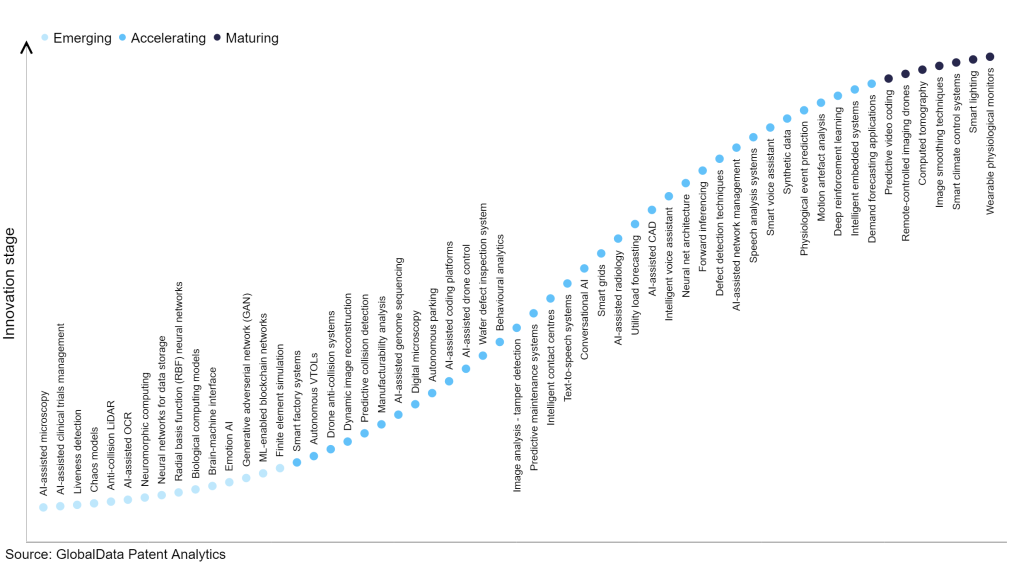The technology industry continues to be a hotbed of innovation, with activity driven by the increasing demand for autonomous vehicles, enhanced safety measures in transportation, and the need for reliable collision avoidance solutions, and growing importance of technologies such as deep learning, computer vision, sensor fusion, and real-time data processing. These advancements in artificial intelligence-powered anti-collision LiDAR contribute to safer and more efficient transportation systems, reducing accidents and improving overall road safety. In the last three years alone, there have been over 3.6 million patents filed and granted in the technology industry, according to Globaldata’s report on Innovation in Artificial Intelligence: Anti-collision LiDAR. Buy the report here.
However, not all innovations are equal and nor do they follow a constant upward trend. Instead, their evolution takes the form of an S-shaped curve that reflects their typical lifecycle from early emergence to accelerating adoption, before finally stabilising and reaching maturity.
Identifying where a particular innovation is on this journey, especially those that are in the emerging and accelerating stages, is essential for understanding their current level of adoption and the likely future trajectory and impact they will have.
300+ innovations will shape the technology industry
According to GlobalData’s Technology Foresights, which plots the S-curve for the technology industry using innovation intensity models built on over 2.5 million patents, there are 300+ innovation areas that will shape the future of the industry.
Within the emerging innovation stage, finite element simulation, ML-enabled blockchain networks, and generative adversarial network (GAN) are disruptive technologies that are in the early stages of application and should be tracked closely. Demand forecasting applications, intelligent embedded systems, and deep reinforcement applications are some of the accelerating innovation areas, where adoption has been steadily increasing. Among maturing innovation areas are wearable physiological monitors and smart lighting which are now well established in the industry.
Innovation S-curve for artificial intelligence in the technology industry

Anti-collision LiDAR is a key innovation area in artificial intelligence
Anti-collision LiDAR refers to a specific form of light detection and ranging (LiDAR) technology designed for collision prevention purposes. Its primary function is to detect objects within a designated area and aid in avoiding collisions. The mechanism involves emitting laser beams into the surroundings, which subsequently bounce back upon encountering nearby objects and are captured by a detector. The collected data is then utilized to construct a three-dimensional map of the environment, enabling the identification and avoidance of potential obstacles.
GlobalData’s analysis also uncovers the companies at the forefront of each innovation area and assesses the potential reach and impact of their patenting activity across different applications and geographies. According to GlobalData, there are 40+ companies, spanning technology vendors, established technology companies, and up-and-coming start-ups engaged in the development and application of anti-collision LiDAR.
Key players in anti-collision LiDAR – a disruptive innovation in the technology industry
‘Application diversity’ measures the number of different applications identified for each relevant patent and broadly splits companies into either ‘niche’ or ‘diversified’ innovators.
‘Geographic reach’ refers to the number of different countries each relevant patent is registered in and reflects the breadth of geographic application intended, ranging from ‘global’ to ‘local’.
Patent volumes related to anti-collision LiDAR
Source: GlobalData Patent Analytics
Ford Motor is a leading patent filer in anti-collision LiDAR. One of the current patents of the company is for a method that uses data from vehicle-mounted sensors to analyse and detect sinkholes in the road ahead. When a sinkhole is identified, the method adjusts vehicle operations, and reports the sinkhole to a shared database or other vehicles.
Other prominent patent filers in this space include Amazon.com and Alphabet.
By geographic reach, ELMOS Semiconductor leads the pack, followed by BAE Systems and SoftBank Group. In terms of application diversity, Aptiv holds the top position, followed by Magna International and Wistron.
Anti-collision LiDAR has revolutionized collision avoidance systems by enhancing their accuracy and efficiency. LiDAR (Light Detection and Ranging) technology utilizes laser beams to measure distances and create detailed 3D maps of the surroundings. With the integration of AI algorithms, anti-collision LiDAR systems can intelligently detect and predict potential collisions, allowing for proactive response and risk mitigation.
To further understand how artificial intelligence is disrupting the technology industry, access GlobalData’s latest thematic research report on Artificial Intelligence (AI) – Thematic Intelligence.
Data Insights
From

The gold standard of business intelligence.
Blending expert knowledge with cutting-edge technology, GlobalData’s unrivalled proprietary data will enable you to decode what’s happening in your market. You can make better informed decisions and gain a future-proof advantage over your competitors.







